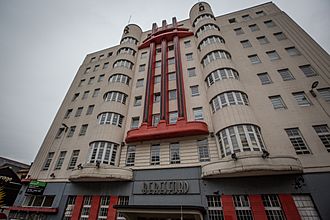Beresford Hotel facts for kids
Quick facts for kids The Beresford |
|
|---|---|

Main facade of The Beresford looking onto Sauchiehall Street
|
|
| Former names | The Beresford Hotel The ICI Building Baird Hall of Residence |
| General information | |
| Status | Complete |
| Type | Residential |
| Architectural style | Art Deco/Streamline Moderne |
| Location | Glasgow, Scotland |
| Address | 460 Sauchiehall Street, Glasgow G2 3LN |
| Coordinates | 55°51′58.4″N 4°16′4.7″W / 55.866222°N 4.267972°W |
| Completed | 1938 |
| Owner | 112 privately owned flats |
| Height | |
| Roof | 30.2 metres (99 ft)(estimated) |
| Top floor | 10 |
| Technical details | |
| Floor count | 10 |
| Lifts/elevators | 2 |
| Design and construction | |
| Architect | William Beresford Inglis |
The Beresford is a famous building located at 460 Sauchiehall Street in Glasgow, Scotland. It first opened in 1938 as a hotel. Many people called it Glasgow's first "skyscraper" because it was the tallest building built in the city between World War I and World War II. It stands seven storeys high. The Beresford is a great example of Art Deco and Streamline Moderne architecture. It is protected as a special "category B listed building" because of its historical importance.
Contents
The Beresford: A Historic Glasgow Building
The Beresford has had an interesting history, changing from a grand hotel to student accommodation, and now to modern homes. Let's explore its journey through the years.
From Hotel to Homes: The Beresford's Journey
The Beresford Hotel: A Grand Opening (1938-1952)
The Beresford Hotel was built for about £170,000. It opened in 1938 just in time for the Empire Exhibition in Glasgow. This big event brought many visitors to the city, and the hotel provided a place for them to stay.
The building's unique style, Art Deco and Streamline Moderne, made it stand out. The architect, William Beresford Inglis, was also the owner and manager of the hotel. During the Second World War, the hotel was used by American and British soldiers. They stayed there while serving their countries.
Baird Hall: A Home for Students (1964-2004)
In 1964, The Beresford building was changed into a place for students to live. This cost about £430,000. It became a student residence for the University of Strathclyde. The building was named Baird Hall after John Logie Baird, a Scottish inventor who created television. His wife, Mrs. Margaret C. Baird, officially opened it on October 25, 1965.
The hall displayed some cool items related to John Logie Baird. These included a working model of his original television and some of his old papers. In 1979, the first female student was allowed to live there. Baird Hall was a home for many students for about 40 years. The University sold the building in 2004.
Modern Living: The Beresford Today (2008-Present)
After closing as student accommodation, The Beresford was empty for a few years. Then, in 2007, work began to turn the building into modern apartments. These new homes were completed and sold in 2008.
Today, The Beresford is divided into 112 privately owned flats. These are small apartments, often with an open-plan kitchen and living area. They also have a compact shower and toilet. Many people use them as a place to stay during the week if they work in Glasgow.

